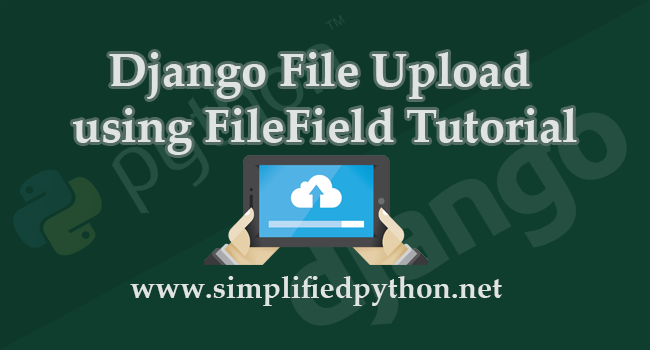

- Django file upload example how to#
- Django file upload example install#
- Django file upload example generator#
- Django file upload example code#
- Django file upload example download#
The submit input will be displayed as a button (by default) that can be pressed by the user to upload the data in all the other input elements in the form to the server (in this case, just the team_name). The matching team label is specified using the label tag (see "Enter name" above), with a for field containing the id value of the associated input. The name and id of the field are used to identify the field in JavaScript/CSS/HTML, while value defines the initial value for the field when it is first displayed. The field's type attribute defines what sort of widget will be displayed. While here we just have one text field for entering the team name, a form may have any number of other input elements and their associated labels. Along the way, we'll extend our LocalLibrary application by adding a form to allow librarians to renew library books, and we'll create pages to create, edit and delete books and authors (reproducing a basic version of the form shown above for editing books). In this tutorial, we're going to show you a few of the ways you can create and work with forms, and in particular, how the generic editing views can significantly reduce the amount of work you need to do to create forms to manipulate your models.
Django file upload example code#
Django Forms take a lot of the work out of all these steps, by providing a framework that lets you define forms and their fields programmatically, and then use these objects to both generate the form HTML code and handle much of the validation and user interaction. Working with forms can be complicated! Developers need to write HTML for the form, validate and properly sanitize entered data on the server (and possibly also in the browser), repost the form with error messages to inform users of any invalid fields, handle the data when it has successfully been submitted, and finally respond to the user in some way to indicate success. While we haven't created any forms in this tutorial so far, we've already encountered them in the Django Admin site - for example, the screenshot below shows a form for editing one of our Book models, comprised of a number of selection lists and text editors. Forms are also a relatively secure way of sharing data with the server, as they allow us to send data in POST requests with cross-site request forgery protection. Forms are a flexible mechanism for collecting user input because there are suitable widgets for entering many different types of data, including text boxes, checkboxes, radio buttons, date pickers and so on. If you have any questions or suggestions about File Upload In Django, please feel free to leave a comment below.An HTML Form is a group of one or more fields/widgets on a web page, which can be used to collect information from users for submission to a server.

Django file upload example generator#

Django file upload example how to#
Django file upload example install#
Step 2: Go inside the project folder, open cmd and type the following commands to install Django Framework and run the webserver:
Django file upload example download#
But If you’re going to focus on web development using Django, you can download here from our list of Best Django Projects with source code based on real-world projects. Urlpatterns += static(settings.MEDIA_URL, document_root=settings.MEDIA_ROOT)Īnyway, if you want to level up your programming knowledge, especially python, try this new article I’ve made for you Best Python Projects with source code for Beginners. Urlpatterns += static(settings.STATIC_URL, document_root=settings.STATIC_ROOT)

Url(r'^$', views.index_redirect, name='views_redirect'), Add a URL to urlpatterns: url(r'^blog/', include('blog.urls'))įrom import include, urlįrom import static Import the include() function: from import url, includeĢ. Add a URL to urlpatterns: url(r'^$', Home.as_view(), name='home')ġ. Add an import: from other_app.views import HomeĢ. Add a URL to urlpatterns: url(r'^$',, name='home')ġ. Add an import: from my_app import viewsĢ. The `urlpatterns` list routes URLs to views.


 0 kommentar(er)
0 kommentar(er)
